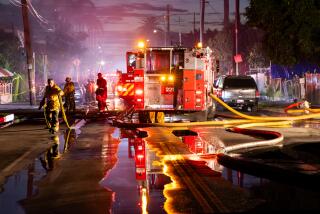In Sylmar, an entire community goes up in flames
“Prepare yourselves for the worst,” Los Angeles Fire Department Capt. Steve Ruda told the crowd of frightened, exhausted people who had been evacuated early Saturday from Sylmar’s Oakridge Mobile Home Park. “I don’t have good news.”
As some of the 200 evacuees wept nearby, Ruda held up a charred, tattered flag. “Let this American flag be a sign of hope,” he said, choking up.
But by day’s end, that hope was hard to cling to, as 501 of the park’s 600 mobile homes had been destroyed and at least 40 more had suffered significant damage.
The park was a scene of devastation, where 50-foot flames had leveled street after street of homes and melted hastily dropped fire hoses into the pavement after even the firefighters were forced to flee. With rare exceptions, only ash and twisted metal remained.
The blaze tore through the mobile home park so fast that firefighters barely had time to rouse people from bed and urge them to safety. Several residents were put into fire engines and rushed out of the neighborhood, in some cases dropped off under freeway overpasses, the nearest safe location, before crews raced back to the battle.
Fire officials said that by early Saturday, the winds had whipped to 50 mph and firefighters reported towering flames and zero visibility. Water mains had run dry or lacked adequate pressure. The conditions became so dangerous that crews, at least for a while, were ordered to evacuate.
“We realized it was a losing battle,” veteran firefighter Steve Marotta said.
Ruth Kamke, 84, had noticed the glow in the sky late Friday night and immediately started gathering her belongings -- clothes, cash and her husband’s ashes -- and packing them into her 1973 mint-condition yellow-and-black Camaro. As she worked, the power flickered off and on. She used her cane to get around.
By 2 a.m., Kamke was ready to leave, but the electricity failed again and she couldn’t open her garage door. Outside, a rain of glowing embers ignited the bushes around her mobile home.
She grabbed a hose and was spraying down her yard when three firefighters appeared and took her by both arms, leading her across the street to a lawn in front of the community clubhouse.
“As I sat there, I watched each house on my block catch fire in turn,” Kamke said.
Desperate to save her car and belongings, she pleaded with firefighters, who eventually broke down the garage door and pulled the vehicle out. One police officer drove the Camaro out of the neighborhood to safety; another put Kamke in his patrol car and took her to the evacuation center. She peered out the rear window and watched the flames consume her home.
“Everything was fire,” Kamke said. “I kept telling them as they were breaking down the garage door, ‘You fight the fire. I’ll take care of myself.’ They said, ‘No, we’re gonna save your car, too.’ ”
Her eyes filled with tears as she recounted the firefighters’ heroism. “What part of my life is left, they saved for me,” she said.
Throughout the long afternoon and evening, the neighborhood remained off-limits to residents, reporters and others not on official business. Spot fires flared, although there was little left to burn.
Residents hiked down a dusty trail to peer into the park over a brick-and-concrete wall. As they stood on tiptoe on blackened tree stumps, they searched for familiar landmarks that might help them spot their homes amid the rubble.
But what they saw looked nothing like the neighborhood several had proudly described as a “country-club-like resort” with a swimming pool, tennis court and billiards tables.
Around the community, a few scattered homes remained. There was one miracle: a yellow house with white trim on Sombrero Street. Firefighters didn’t know why it had survived when everything around it was gone.
“This is one of those that will go down in my memory for a long time,” Los Angeles Fire Capt. Andrew Ruiz said.
But retired school bus drivers Linda Pogacnik, 63, and Nodonda Baldwin, 56, were not so lucky. Nothing was left of the 1,500-square-foot modular home they had pooled their savings to buy.
“My street -- ashes,” Pogacnik said, crying uncontrollably. “It was the Beverly Hills of mobile home parks. . . . We had a view, trees, a yard and neighbors. We felt so safe there. It was a perfect place for an old retired woman.”
The trees were now gone and the grass charred. At most homes nearby, all that remained were brick steps leading to now-missing front doors and an occasional charred stove or melted car frame.
At 515 Sombrero, the only things still standing were a mailbox and a sign flapping in the wind.
It read: “For Sale.”
Sahagun, Wagner and Song are Times staff writers.
Times staff writers Esmeralda Bermudez and Kimi Yoshino contributed to this report.
More to Read
Start your day right
Sign up for Essential California for news, features and recommendations from the L.A. Times and beyond in your inbox six days a week.
You may occasionally receive promotional content from the Los Angeles Times.







